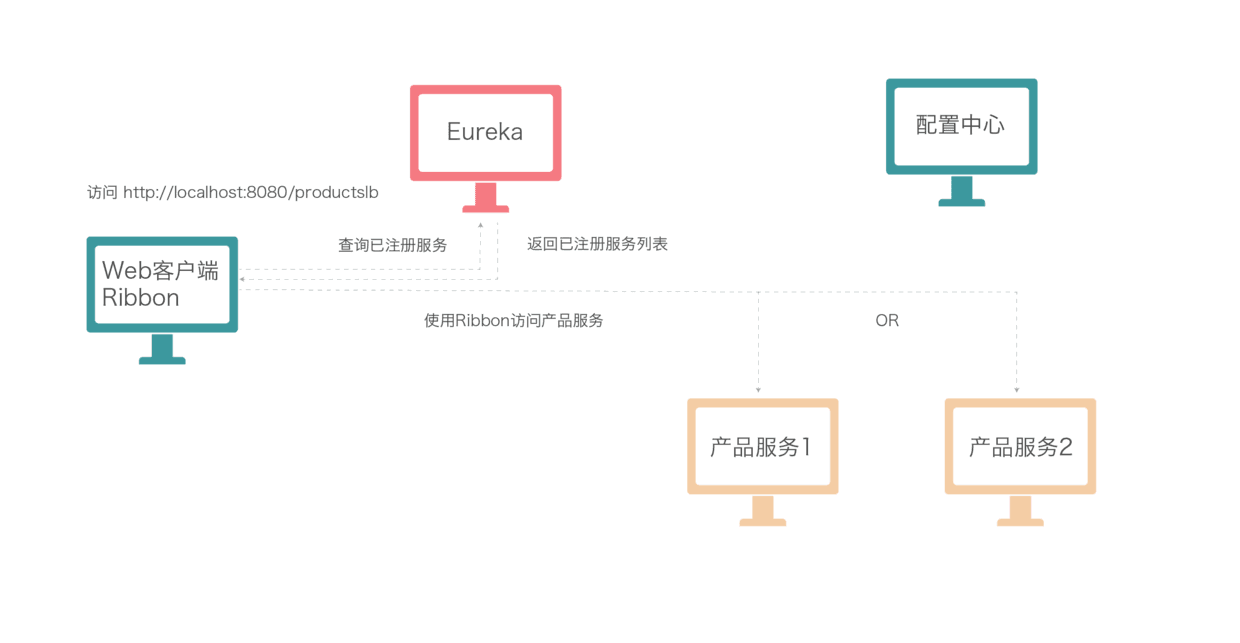简介

我们继续以之前博客的代码为基础,增加ribbon组件来提供客户端负载均衡。负载均衡是实现高并发、高性能、可伸缩服务的重要组成部分,它可以把请求分散到一个集群中不同的服务器中,以减轻每个服务器的负担。客户端负载均衡是运行在客户端程序中的,如我们的web项目,然后通过获取集群的ip地址列表,随机选择一个server发送请求。相对于服务端负载均衡来说,它不需要消耗服务器的资源。
基础环境
- jdk 1.8
- maven 3.3.9
- intellij 2018.1
git:项目源码
更新配置
我们这次需要在本地启动两个产品服务程序,用来验证负载均衡,所以需要为第二个程序提供不同的端口。spring cloud配置服务中心的配置默认会覆盖本地系统环境变量,而我们需要通过系统环境变量来设置产品服务的端口,所以需要在配置中心git仓库中修改产品服务的配置文件product-service.yml
|
1
2
3
4
5
6
7
|
server: port: 8081spring: cloud: config: allow-override: true override-system-properties: false |
allow-override的默认值即为true,写出它来是想作说明,它的意思是允许远程配置中心的配置项覆盖本地的配置,并不是说允许本地的配置去覆盖远程的配置。当然我们可以把它设置成false,但是为了提供更精确的覆盖规则,这里保留了默认值。
我们添加了override-system-properties=false,即虽然远程配置中心的配置文件可以覆盖本地的配置,但是不要覆盖本地系统变量。修改完成后提交到git仓库。
另外,在productservice项目的productcontroller中添加一些log,用来验证负载均衡是否生效:
|
1
2
3
4
5
6
7
8
9
10
11
12
13
14
15
|
package cn.zxuqian.controllers;import org.slf4j.logger;import org.slf4j.loggerfactory;import org.springframework.web.bind.annotation.requestmapping;import org.springframework.web.bind.annotation.restcontroller;@restcontrollerpublic class productcontroller { private static logger log = loggerfactory.getlogger(productcontroller.class); @requestmapping("/products") public string productlist() { log.info("access to /products endpoint"); return "外套,夹克,毛衣,t恤"; }} |
为web配置ribbon
首先在pom.xml中添加ribbon的依赖:
|
1
2
3
4
|
<dependency> <groupid>org.springframework.cloud</groupid> <artifactid>spring-cloud-starter-netflix-ribbon</artifactid></dependency> |
然后修改application类,添加如下代码:
|
1
2
3
4
5
6
7
8
9
10
11
12
13
14
15
|
@enablecircuitbreaker@enablediscoveryclient@ribbonclient(name = "product-service")@springbootapplicationpublic class application { public static void main(string[] args) { springapplication.run(application.class, args); } @bean @loadbalanced public resttemplate rest(resttemplatebuilder builder) { return builder.build(); }} |
这里用到了@ribbonclient(name = "product-service")注解,用来标记此项目为ribbon负载均衡的客户端,它需要选择产品服务集群中其中的一台来访问所需要的服务,这里的name属性对应于productservice项目中配置的spring.application.name属性。
@loadbalanced注解标明了resttemplate会被配置为自动使用ribbon的loadbalancerclient来选择服务的uri并发送请求。
在我们在productservice类中添加如下代码:
|
1
2
3
4
5
6
7
8
9
10
11
12
13
14
15
16
17
18
19
20
21
22
23
24
25
26
27
|
@servicepublic class productservice { private final resttemplate resttemplate; @autowired private discoveryclient discoveryclient; public productservice(resttemplate resttemplate) { this.resttemplate = resttemplate; } @hystrixcommand(fallbackmethod = "backupproductlist") public string productlist() { list<serviceinstance> instances = this.discoveryclient.getinstances("product-service"); if(instances != null && instances.size() > 0) { return this.resttemplate.getforobject(instances.get(0).geturi() + "/products", string.class); } return ""; } public string backupproductlist() { return "夹克,毛衣"; } public string productlistloadbalanced() { return this.resttemplate.getforobject("http://product-service/products", string.class); }} |
这里新添加了一个productlistloadbalanced方法,跟之前的productlist方法访问的是同一服务,只不过是用ribbon client去做了负载均衡,这里的uri的host变成了product-service即要访问的服务的名字,跟@ribbonclient中配置的name属性保持一致。最后在我们的productcontroller中添加下面的代码:
|
1
2
3
4
5
6
7
8
9
10
11
12
13
14
15
16
|
@restcontrollerpublic class productcontroller { @autowired private productservice productservice; @requestmapping("/products") public string productlist() { return productservice.productlist(); } @requestmapping("/productslb") public string productlistloadbalanced() { return productservice.productlistloadbalanced(); }} |
来创建一个专门处理/productslb请求的方法,调用productservie提供负载均衡的方法。
到这里我们的代码就完成了,代码看似简单,其实是所有的配置都使用了默认值。ribbon提供了编程式和配置式两种方式来配置ribbon client。现简单介绍下,后续深入ribbon时再和大家一起看看如何修改它的配置。ribbon提供如下配置(左边是接口,右边是默认实现):
- iclientconfig ribbonclientconfig: defaultclientconfigimpl
- irule ribbonrule: zoneavoidancerule
- iping ribbonping: dummyping
- serverlist<server> ribbonserverlist: configurationbasedserverlist
- serverlistfilter<server> ribbonserverlistfilter: zonepreferenceserverlistfilter
- iloadbalancer ribbonloadbalancer: zoneawareloadbalancer
- serverlistupdater ribbonserverlistupdater: pollingserverlistupdater
因为我们这个项目用了eureka,所以有些配置项和默认实现有所不同,如eureka使用discoveryenabledniwsserverlist取代ribbonserverlist来获取在eureka上注册的服务的列表。下边有一个简单的congiguration类,来自spring官网:
|
1
2
3
4
5
6
7
8
9
10
11
12
13
14
15
|
public class sayhelloconfiguration { @autowired iclientconfig ribbonclientconfig; @bean public iping ribbonping(iclientconfig config) { return new pingurl(); } @bean public irule ribbonrule(iclientconfig config) { return new availabilityfilteringrule(); }} |
ribbon默认不会发送ping检查server的健康状态,默认均正常,然后irune默认实现为zoneavoidancerule用来避免aws ec2问题较多的zone,这在本地测试环境来说是用不到的,然后替换成了availabilityfilteringrule,这个可以开启ribbon自带的断路器功能,来过滤不正常工作的服务器。
测试
首先启动我们的configserver配置中心服务,然后启动registry eureka注册与发现服务,然后启动两个productservice,第一个我们可以正常使用spring-boot:run插件来启动,第二个我们需要给它提供一个新的端口,可以用如下命令启动:
|
1
|
$ server_port=8082 mvn spring-boot:run |
最后启动我们的web客户端项目,访问http://localhost:8080/productslb,然后刷新几次,会看到运行着productservice的两个命令行窗口会随机出现我们的log:
|
1
|
access to /products endpoint |
以上就是本文的全部内容,希望对大家的学习有所帮助,也希望大家多多支持服务器之家。
原文链接:https://blog.csdn.net/fengqiuzhihua/article/details/80205923















